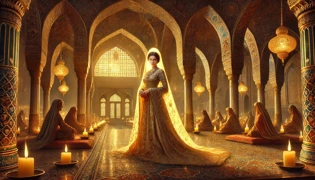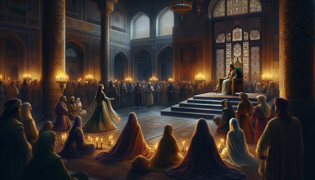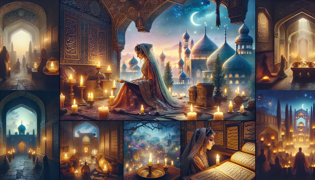Scheherazade: The Enchanting Queen of Tales
Reading Time: 11 min

About Story: Scheherazade: The Enchanting Queen of Tales is a Legend from iran set in the Medieval. This Poetic tale explores themes of Wisdom and is suitable for All Ages. It offers Cultural insights. A captivating narrative of a queen whose timeless stories saved her life and transformed a kingdom.
Introduction
In the heart of ancient Persia, where the winds carried whispers of legendary heroes and forgotten lore, there stood a palace as resplendent as the dreams of its people. Here, beneath graceful arches adorned with intricate mosaic work and delicate carvings, life moved to the rhythm of timeless traditions. The twilight sky draped the city in hues of deep indigo and gold, as if it were an eternal canvas painted by the gods. In one of the grand chambers of the palace, where the soft glow of countless candles danced over silken draperies and polished marble, lived Scheherazade—a woman of extraordinary vision and courage.
Her eyes, shimmering with both sorrow and hope, often searched the ancient texts and scrolls that spoke of magic and fate. With every breath, she absorbed the spirit of her people; with every heartbeat, she channeled the stories of old, intertwined with the mysteries of destiny. In a time when the cruelty of kings had dimmed the light of millions, Scheherazade was both beacon and refuge. Her voice, tender yet resolute, possessed the power to tame even the most savage of hearts. It was said that in the quiet resonance of her words, the very air shimmered with enchantment.
That fateful evening, as a hush blanketed the palace corridors and the solemn murmur of anticipation filled the gathering hall, Scheherazade prepared to embark on her nightly ritual. Not merely a recitation of tales, her storytelling became a gentle rebellion—a declaration that art and wisdom could revive a fractured soul. The stage was set for a tale that would not only weave together the threads of human sorrow and triumph but would also plant the seeds of redemption in a land steeped in despair.
A Night of Beginnings
The night was pregnant with possibility and trepidation. In the grand hall of the palace, the soft murmur of voices hushed as the heavy wooden doors creaked open and formal silence took hold. Scheherazade stepped forward, her graceful stride belying the inner storm of emotions that wracked her heart. For over a dozen nights, she had danced with fate, offering the enthralling cadence of her spoken word as delicately as the petals of a rare flower. This night, too, would herald the birth of another narrative—a story of miraculous redemption and subtle defiance.
At the center of the hall, King Shahryar sat upon an imposing throne of gilded wood and polished marble, his face drawn and lined by the years of harsh judgment and shattered trust. The king, whose soul had sunk under the weight of perpetual betrayal, listened intently, his piercing gaze narrowing as the first notes of Scheherazade’s voice caressed his ears. Her narrative began slowly, like the quiet ripple of water over ancient stone, drawing him into a realm where danger and beauty were seamlessly interlaced.
Scheherazade wove a tale of a forlorn traveler venturing through enchanted valleys and towering citadels—lands where the sands whispered secrets and the stars served as silent witnesses to acts of love and despair. In her careful choice of words, the traveler's hardships became a mirror to the king's own tormented past, and his unexpected acts of compassion reflected the buried goodness within him. Every phrase was imbued with the wisdom of old, and every pause was a tribute to lives lost and lessons learned.
As the audience leaned forward in anticipation, the king’s once hardened expression slowly softened. Scheherazade’s narrative did more than entertain; it offered a glimpse of a world where errors could be forgiven and hearts might mend. Her voice, gentle like the rustle of autumn leaves, spun images of bustling bazaars scented with saffron and rose water, tranquil courtyards brimming with ancient olive trees, and moonlit rivers that carried dreams downstream. The room was filled with an almost tangible hope—a promise that every darkened soul had a spark waiting to be ignited.
In that magic-laden moment, Scheherazade realized that the power of her storytelling could serve as both shield and sword. For each carefully recounted tale, she not only lured the king away from his vengeful inclinations but also breathed life into a dormant kingdom yearning for liberation. With every word, she etched a new chapter in the chronicles of a land poised on the brink of transformation. The night had only just begun, yet within it lay the seeds of redemption, sown by a storyteller whose art was as potent as it was beautiful.

The Labyrinth of Fate
As the night deepened, Scheherazade’s narrative carried her listeners further into the realm of myth and mystery. In a tale set in an enchanted desert, she recounted the journey of a young hero named Rostam, whose life was as tangled as the labyrinthine pathways of fate itself. Rostam, orphaned by a miscalculation of destiny, roamed the vast, shimmering dunes in search of solace, armed only with a profound belief that love and truth could conquer the cruelty of destiny.
The narrative unfolded with lush descriptions of the mighty desert—a sea of undulating sand, illuminated by a moon that hung like a guardian over secret oases. Rostam encountered mystical creatures, ethereal beings with eyes that sparkled like starlight, and spirits of the ancients that whispered wisdom on the cool night breeze. With each encounter, he gained fragments of knowledge, patching together clues that led him through tempting mirages and perilous traps. His journey was both physical and metaphysical, a battle between his inner demons and the luminous hope that flickered within him.
Scheherazade’s voice, sonorous and measured, led the listeners through the winding paths of Rostam’s ordeals. In scenes where the desert’s harsh reality gave way to an almost dreamlike quality, the hero found sanctuary beneath palm trees that swayed gently in the warm night air, their leaves murmuring secrets of forgotten eras. The intricate interplay of danger and beauty painted an epic panorama of survival and the persistent pulse of life.
As she spoke, Scheherazade interwove metaphors of the human experience into Rostam’s quest. The labyrinth was not only a physical maze but a symbolic journey through the dark corridors of the soul. It was a call to awaken the dormant virtues of courage, compassion, and resilience. The climactic confrontation between Rostam and a spectral guardian—a representation of fate itself—was described with such vivid detail that the audience could almost feel the cold, ghostly hand of destiny. Yet, in the depths of that confrontation, a ray of benevolence emerged, suggesting that even in the direst moments, the human spirit can prevail.
In the silences between her words, the timeless desert seemed to stretch beyond the walls of the palace, inviting every listener to embark on their own inward pilgrimage. Scheherazade’s tale of Rostam transcended its narrative boundaries, echoing the struggles and triumphs of all who dared to face their destiny. The labyrinth of fate, intricate and unpredictable, was met with the clarity of a voice that believed in redemption and the transformative power of narrative.

Whispers of the Past
In the quiet aftermath of her previous tales, Scheherazade allowed herself a moment of introspection—a deep communion with the echoes of her own life. In this section of her narrative, the storyteller queen recounted the secret origins of her passion for words and wonder. Born into a lineage of ancient scribes and poets whose verses flowed like the mighty rivers of Persia, she had inherited not only a legacy of wisdom but also the burden of witnessing her people’s sorrows.
Under the star-strewn skies of her childhood, young Scheherazade would sit at the feet of her grandmother, listening to long-forgotten fables whispered by the flickering fire. Those early memories were imbued with both beauty and melancholy—the cadence of sorrow mingled with hope, like water and wine. Her life had been a mosaic of luminous moments—each a delicate shard of passion and wisdom—yet also marred by the brutal realities of a kingdom where betrayal and loss were as common as breaths in the air.
With an almost trembling softness, she revealed how the art of storytelling became her sanctuary. Words, for her, were not mere sounds but living entities that could heal, transform, and even defy the inexorable march of time. As she recalled the ravages of war and the relentless cruelty of those in power, her narrative shifted seamlessly into a personal meditation on the resilience that arises from embracing one’s history. The ancient walls of the palace, laden with the scars of past conflicts, became a metaphor for her own heart—mended slowly by the careful stitching of memories and the tender craft of narrative.
Her recollections were punctuated by vivid imagery of long corridors lined with ancient script, illuminated by the soft glow of oil lamps. With each fragment of her past unveiled, the audience felt the depth of her soul—a reservoir of courage and vulnerability. Scheherazade’s voice, now resonant with intimate confession, evoked the timeless truth that every life is a tapestry woven from both light and shadow. In revealing her personal history, she reminded her listeners that every story, however harrowing, could serve as a bridge between despair and hope.

The Dawn of Redemption
As the predawn light began to seep through the towering windows of the palace, the final chapter of Scheherazade’s nightly narrative emerged—a tale of transformation and redemption that promised the renewal of a tormented soul. In this climactic segment, the emperor of hearts, King Shahryar, found himself at the crossroads of destiny. The countless nights of listening had, over time, softened the edges of a heart hardened by betrayal. The king’s eyes, once cold and unforgiving, now shimmered with a tentative hope as he absorbed the concluding parable of a kingdom reborn.
Scheherazade described a land where the wounded were healed by the gentle balm of forgiveness, and where the scars of ancient wrongs were honored as part of the tapestry of life. In her tale, a mighty river that had long run red with sorrow was transformed into a life-giving stream through the art of redemption. The imagery was vivid—a breathtaking sunrise over verdant hills drenched in dew, where the first light of the new day washed away the remnants of darkness. The narrative reached into the heart of every listener, urging them to dare to dream and to trust in the endless potential for reinvention.
With each measured word, Scheherazade built a bridge between the shadows of the past and the radiant promise of the future. The royal courtiers, who had once whispered in fear and uncertainty, now found their voices united in an unspoken chorus of healing. Even the king, grieved by the weight of his own misdeeds, began to believe that his soul could be cleansed by the transformative power of compassion.
In that final, luminous moment before the break of day, the storyteller queen’s voice rose like a gentle benediction. Her narrative, rich with the wisdom of ancient lore and the tender hope of a new era, affirmed that every ending contains within it the possibility of a new beginning. The palace itself seemed to exhale a long-held breath, as though the walls too were relieved to witness the dawn of redemption. Scheherazade’s legacy was not merely one of survival, but of transformation—a reminder that even amid cruelty and despair, the human spirit can be reborn through the enchanted art of storytelling.

Conclusion
As the final echoes of Scheherazade’s voice faded into the early light, the palace and its people were forever transformed. The once relentless chill in the king’s heart had thawed under the steady warmth of her stories, which had acted as both salve and catalyst. In the glow of the emerging sun, King Shahryar, now humbled and enlightened, vowed to embrace the lessons of compassion and forgiveness that had been sown through each carefully crafted narrative. His transformation was not immediate, but the seeds of change had been irrevocably planted in the hearts of his subjects and in his own weary soul.
In the quiet hours before the bustle of the new day, whispers of hope mingled with the cool morning air. The spectators of Scheherazade’s nightly ritual recognized that her art was far more than a means of survival—it had become a beacon of rebirth for a kingdom steeped in ancient grief. The storyteller queen, once herself a captive of fate, had redefined destiny through the simple power of a well-spun tale. She had shown that words, when imbued with deep truth and compassion, could dissolve even the harshest decrees of cruelty.
In that tender dawn, as the palace walls resonated with a newfound mercy and the king’s decree of vengeance was replaced by measures of justice and empathy, Scheherazade’s legacy presaged a future in which storytelling would reign as the supreme remedy for division and despair. Her narrative journey had proven that every soul possesses the capacity for renewal, and that every heart, however scarred, can be redeemed by the power of hope. Thus, the enchantment of her tales continued to live on—not merely in whispered legends, but in the enduring transformation of a people reborn into light.

















